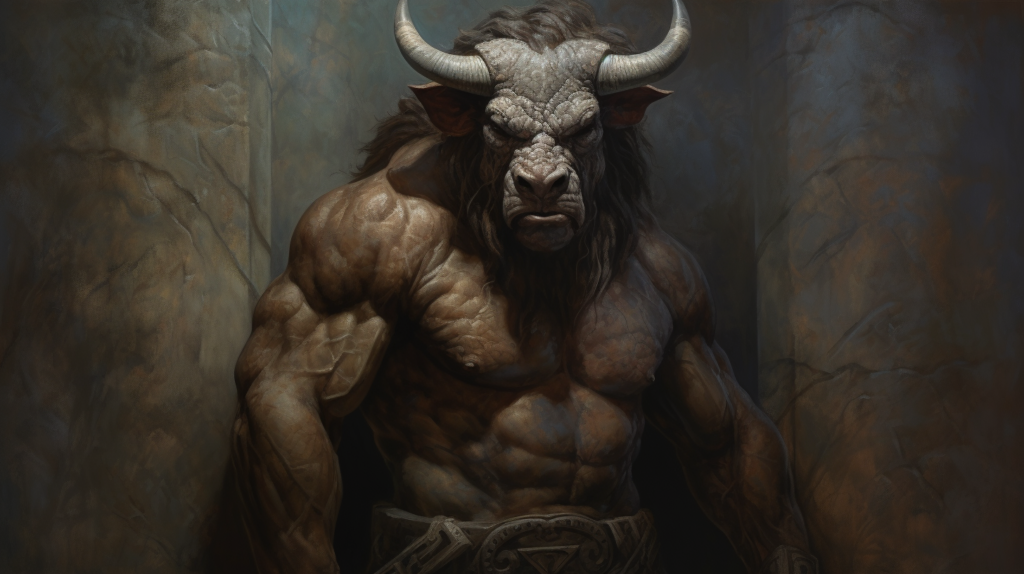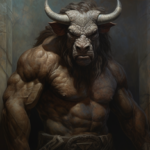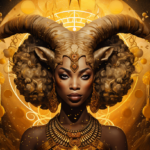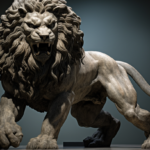Are you ready to delve into the mystery of the Minotaur? Get ready to uncover the secrets of this mythical creature, with its half-bull, half-man form.
In this article, we will explore the origins of the Minotaur, the infamous labyrinth that served as its prison, and the epic battle between Theseus and the fearsome beast.
Discover the powerful symbolism and interpretations behind the Minotaur, and how its legacy continues to captivate modern culture.
Join us on this intimate journey into the world of the Minotaur.
Key Takeaways
- The Minotaur is a mythical creature born from the union of a bull and a human woman, serving as a representation of the amalgamation of man and beast.
- The Labyrinth, designed by Daedalus, was created to confine the Minotaur and symbolizes both the creature’s imprisonment and the internal struggles faced by individuals.
- Theseus’s battle with the Minotaur represents the clash between intellect and cunning, reflecting the struggle between good and evil in Greek society.
- The Minotaur’s symbolism extends beyond Greek mythology, inspiring various forms of art, literature, and entertainment, and exploring themes of darkness, isolation, identity, and the struggle between good and evil.
The Origins of the Minotaur
Learn about the origins of the Minotaur, a mythical creature that was born from the union between a bull and a human woman. The story of the Minotaur has its roots in ancient Greek mythology, where it has been passed down through generations. According to evolutionary theories, the Minotaur is believed to represent the amalgamation of man and beast, symbolizing the primal instincts that exist within all of us.
In ancient Greek mythology, the Minotaur was said to be the offspring of King Minos’ wife, Pasiphae, and a sacred bull. This unnatural union was a result of a curse placed upon King Minos by the god Poseidon. The birth of the Minotaur was seen as a punishment for the sins committed by the royal family.
The existence of the Minotaur highlights the complex nature of human desires and the unpredictable consequences that can arise from them. It serves as a reminder of the dangers that lie within our own instincts and the potential for darkness that resides within us all.
As we delve deeper into the origins of the Minotaur, we’ll discover the intriguing tale of the labyrinth, a prison designed specifically for this mythical creature. This labyrinth served as both a physical and metaphorical representation of the Minotaur’s imprisonment and the internal struggles faced by those who are trapped by their own primal instincts.
The Labyrinth: A Prison for the Minotaur
You will now uncover the significance of the labyrinth as the prison for the Minotaur, a mythical creature consisting of part bull and part man. The Minotaur’s physical characteristics, a grotesque combination of strength and bestiality, made him a fearsome being in Greek mythology. With the head of a bull and the body of a man, he towered over his human captors.
The labyrinth, an intricate maze designed by the master craftsman Daedalus, served as the Minotaur’s prison. Its purpose was twofold: to confine the Minotaur and to prevent his escape. The labyrinth’s complex layout, with its twisting corridors and dead ends, made it nearly impossible for anyone to find their way out. It was a prison of isolation and despair, where the Minotaur was condemned to roam endlessly, forever separated from the outside world.
The Minotaur’s role in Greek mythology was as a symbol of primal savagery and the consequences of unchecked desires. His imprisonment in the labyrinth served as a cautionary tale, reminding us of the dangers of giving in to our innermost urges and the importance of self-control.
Theseus and the Minotaur: A Battle of Wits
The encounter between Theseus and the Minotaur was a clash of intellect and cunning. Theseus, the brave hero, ventured into the Labyrinth, armed with nothing but his wits and determination. It was a battle of wits, as Theseus had to outsmart the fearsome Minotaur, a creature half man and half bull.
The myth of Theseus and the Minotaur holds great significance in ancient Greek society, as it reflects the eternal struggle between good and evil, and the triumph of the human spirit over monstrous forces.
In ancient Greek society, myths played a vital role in shaping cultural beliefs and values. The story of Theseus and the Minotaur was no exception. It served as a cautionary tale, warning against the consequences of unchecked power and the importance of courage and intelligence. Theseus, with his clever maneuvering and strategic thinking, embodied the virtues that were highly prized in Greek society.
The battle between Theseus and the Minotaur symbolizes the internal struggle faced by individuals in their quest for self-discovery and overcoming personal demons. It teaches us that we must confront our fears and navigate through the maze of life, using our intellect and cunning to emerge victorious.
In the subsequent section, we’ll explore the deeper symbolism and interpretations of the Minotaur, shedding light on its significance beyond the mythological realm.
Symbolism and Interpretations of the Minotaur
What deeper meanings and interpretations can be attributed to the Minotaur, a mythical creature that’s part bull and part man? The Minotaur holds a profound symbolic meaning that has fascinated scholars and psychologists alike. Here are three intriguing interpretations that shed light on the significance of this enigmatic creature:
- The Beast Within: The Minotaur is often seen as a representation of the primal and instinctual nature that resides within every human. It symbolizes our darker impulses and urges, which must be confronted and tamed in order to achieve personal growth and self-actualization.
- The Labyrinth of the Mind: The intricate labyrinth that houses the Minotaur is often interpreted as a metaphor for the human psyche. Just as Theseus navigates the labyrinth to confront the Minotaur, individuals must delve into the depths of their own minds, facing their inner demons and fears, in order to find enlightenment and self-awareness.
- The Duality of Nature: The hybrid nature of the Minotaur reflects the inherent duality within human beings. It represents the constant struggle between our animalistic instincts and our rational, civilized selves, reminding us of the delicate balance we must maintain in order to lead fulfilling lives.
With these symbolic meanings and psychological interpretations in mind, it’s clear that the Minotaur holds a profound significance in our understanding of the human condition.
Transitioning into the next section, we’ll explore how the legacy of the Minotaur continues to resonate in modern culture.
The Legacy of the Minotaur in Modern Culture
As you explore the legacy of the Minotaur in modern culture, it becomes evident that this mythical creature continues to captivate and inspire various forms of art, literature, and entertainment. From pop culture portrayals to its profound influence on literature, the Minotaur remains a symbol that resonates with audiences even today.
In the realm of pop culture, the Minotaur has made numerous appearances, solidifying its status as a timeless icon. It has graced the silver screen, with films like ‘Percy Jackson & The Olympians: The Lightning Thief’ and ‘Immortals’ showcasing its powerful presence. It has also found its way into television shows, such as the critically acclaimed series ‘American Gods’, where it embodies both fear and fascination.
In literature, the Minotaur has left an indelible mark. Its labyrinthine nature and the themes of duality and monstrosity it represents have inspired countless authors. Notable examples include Jorge Luis Borges’ ‘The House of Asterion’ and David Mitchell’s ‘The Bone Clocks’. In these works, the Minotaur becomes a metaphor for the darkness within humanity, exploring themes of isolation, identity, and the struggle between good and evil.
Frequently Asked Questions
What Is the Scientific Classification of the Minotaur?
The scientific classification of the minotaur is a subject of debate. Despite the lack of concrete evidence, many believe it to be a mythical creature. Its existence remains shrouded in mystery.
Are There Any Existing Physical Remains or Artifacts That Provide Evidence of the Minotaur’s Existence?
There’s no physical evidence of the Minotaur’s existence, but historical depictions give us a glimpse into the mythical creature. It’s fascinating to imagine how the part bull, part man creature was portrayed in ancient times.
How Did the Greek Society View the Minotaur’s Hybrid Nature and What Were the Cultural Implications?
In Greek society, the minotaur’s hybrid nature was seen as both fascinating and unsettling. Its symbolism represented the duality of human instincts and the consequences of succumbing to our animalistic desires.
Are There Any Other Mythological Creatures Similar to the Minotaur in Different Cultures?
Are there other creatures like the Minotaur in different cultures? Yes, many cultures have their own versions of hybrid creatures, each with their own cultural significance. Let’s explore these fascinating mythical beings together!
How Has the Portrayal of the Minotaur Evolved Over Time in Literature, Art, and Popular Culture?
Over time, the minotaur’s portrayal in literature and art has evolved. It has become more complex and multidimensional, reflecting the changing perceptions of human nature. In popular culture, the minotaur is often depicted as a fearsome and formidable creature.







